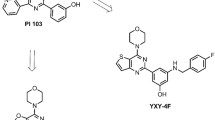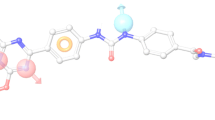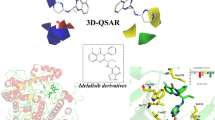Abstract
Phosphatidylinositol 3-kinase (PI3K) is a key regulatory kinase in the PI3K/AKT/mTOR signaling pathway, which is involved in the regulation of cell proliferation, differentiation, apoptosis, and angiogenesis. Class IA PI3K isoforms γ and δ share a highly homologous ATP binding site and are distinguished by only a few residues around the binding site. Subtype-selective inhibitors have been proven to have great advantages in tumor treatment. Preliminary studies have obtained PI3K inhibitors bearing a benzimidazole structural motif with a certain selectivity for PI3Kδ and PI3Kγ subtypes. On this basis, we investigated the selective inhibitory mechanism of PI3Kδ and PI3Kγ using four developed inhibitors via molecular docking, molecular dynamics, binding free energy calculations, and residue energy decomposition. This study could provide references for the further development of PI3K-isoform-selective inhibitors.
Graphical abstract








Similar content being viewed by others
Data Availability
All the data and material can be easily assessed in manuscript and supporting information (SI).
Code availability
SYBYL-X (2.0, own copyright), LigPlus (V.2.2.4, open source), AutoDockTools (V.1.5.6, open source), AutoDock Vina program (V.1.1.2, open source), AMBER 16 (own copyright), and PyMOL (V.2.1.1,open source).
References
Cantley L (2002) The phosphoinositide 3-kinase pathway. Science 296(5573):1655–1657
Leevers SJ, Vanhaesebroeck B (1999) Signalling through phosphoinositide 3-kinases: the lipids take centre stage. Curr Opin Cell Biol 11(2):219–225
Fresno Vara JA, Casado E, De-Castro J et al (2004) PI3K/Akt signalling pathway and cancer. Cancer Treat Rev 30(2):193–204
Yuan TL, Cantley LC (2008) PI3K pathway alterations in cancer: variations on a theme. Oncogene 27(41):5497–5510
Vivanco I, Sawyers CL (2002) The phosphatidylinositol 3-kinase AKT pathway in human cancer. Nat Rev Cancer 2(7):489–501
Jackson SP, Schoenwaelder SM (2012) Antithrombotic phosphoinositide 3-kinase β inhibitors in humans: a ‘shear’ delight! J Thromb Haemost 10(10):2123–2126
Greenwell IB, Flowers CR, Blum KA et al (2017) Clinical use of PI3K inhibitors in B-cell lymphoid malignancies: today and tomorrow. Expert Rev Anticancer Ther 17(3):271–279
Hirsch E, Morello F, Ciraolo E (2011) Present and future of PI3K pathway inhibition in cancer: perspectives and limitations. Curr Med Chem 18(18):2674–2685
Sundstrom TJ, Anderson AC, Wright DL (2009) Inhibitors of phosphoinositide-3-kinase: a structure-based approach to understanding potency and selectivity. Organic & Biomolecular Chemistry 7(1):840–850
Dwyer CJ, Arhontoulis DC, Rangel RGO et al (2020) Ex vivo blockade of PI3K gamma or delta signaling enhances the antitumor potency of adoptively transferred CD8+ T cells. Eur J Immunol 50(9):1386–1399
Puri KD, Di Paolo JA, Gold MR (2013) B-cell receptor signaling inhibitors for treatment of autoimmune inflammatory diseases and B-cell malignancies. International Reviews Immunology 32(4):397–427
Costa C, Hirsch E (2010) More than just kinases: the scaffolding function of PI3K. Curr Top Microbiol Immunol 346(1):171–181
Lee JY, Chiu YH, Asara J et al (2011) Inhibition of PI3K binding to activators by serine phosphorylation of PI3K regulatory subunit p85α Src homology-2 domains. Proc Natl Acad Sci 108(34):14157–14162
Thorpe LM, Yuzugullu H, Zhao JJ (2015) PI3K in cancer: divergent roles of isoforms, modes of activation and therapeutic targeting. Nature reviewsCancer 15(1):7–24
Knight ZA, Gonzalez B, Feldman ME et al (2006) A pharmacological map of the PI3-K family defines a role for p110α in insulin signaling. Cell 125(4):733–747
Elmenier FM, Lasheen DS, Abouzid (2019) Phosphatidylinositol 3 kinase (PI3K) inhibitors as new weapon to combat cancer. European Journal of Medicinal Chemistry 183:111718
Zhang JQ, Luo YJ, Xiong YS et al (2016) Design, synthesis, and biological evaluation of substituted pyrimidines as potential phosphatidylinositol 3-kinase (PI3K) inhibitors. J Med Chem 59(15):7268–7274
Wu TT, Guo QQ, Chen ZL, Wang LL, Du Y, Chen R, Mao YH, Yang SG, Huang J, Wang JT, Wang L, Tang L, Zhang JQ (2020) Design, synthesis and bioevaluation of novel substituted triazines as potential dual PI3K/mTOR inhibitors. European Journal of Medicinal Chemistry 204:112637
Dubey A, Kalra S (2013) Computational comparative modeling and visualization for HIV1 and HIV2 proteins via the software SYBYL-X 2.0. International Journal of Scientific and Research Publications 3(10):1–6
Laskowski RA, Swindells MB (2011) LigPlot+: multiple ligand-protein interaction diagrams for drug discovery. Journal Chem Inf Model 51(10):2778–2786
Sanner MF (1999) Python: a programming language for software integration and development. Journal of Molecular Graphics Modeling 17(1):57–61
Trott O, Olson AJ, Trott O, Olson AJ (2010) AutoDock Vina: improving the speed and accuracy of docking with a new scoring function, efficient optimization, and multithreading. J Comput Chem 31(2):455–461
Salomon-Ferrer R, Case DA, Walker RC (2013) An overview of the Amber biomolecular simulation package. WIREs Comput Mol 3(2):198–210
Pemberton OA, Zhang X, Chen Y (2017) Molecular basis of substrate recognition and product release by the Klebsiella pneumoniae Carbapenemase (KPC-2). J Med Chem 60(8):3525–3530
Folkes AJ, Ahmadi K, Alderton WK et al (2008) The identification of 2-(1H-Indazol-4-yl)-6-(4-methanesulfonyl-piperazin-1-ylmethyl)-4-morpholin-4-yl-thieno[3,2-d]pyrimidine (GDC-0941) as a potent, selective, orally bioavailable inhibitor of class I PI3 kinase for the treatment of cancer. J Med Chem 51(18):5522–5532
Berndt A, Miller S, Williams O et al (2010) The p110δ structure: mechanisms for selectivity and potency of new PI(3)K inhibitors. Nat Chem Biol 6(2):117–124
Zhu JY, Ke K, Xu L, Jin J (2019) Theoretical studies on the selectivity mechanisms of PI3Kδ inhibition with marketed idelalisib and its derivatives by 3D-QSAR, molecular docking, and molecular dynamics simulation. J Mol Model 25(8):242
Esra K, Cyntia T, Stéphane B et al (2017) Derivation of original RESP atomic partial charges for MD simulations of the LDAO surfactant with AMBER: applications to a model of micelle and a fragment of the lipid kinase PI4KA. J Biomol Struct Dyn 35(1):159–181
Mecklenfeld A, Raabe G (2017) Comparison of RESP and IPolQ-Mod partial charges for solvation free energy calculations of various solute/solvent pairs. J Chem Theory Comput 13(12):6266–6274
Maier JA, Martinez C, Kasavajhala K et al (2015) ff14SB: Improving the accuracy of protein side chain and backbone parameters from ff99SB. J Chem Theory Comput 11(8):3696–3713
Jorgensen WL, Chandrasekhar J, Madura JD et al (1998) Comparison of simple potential functions for simulating liquid water. J Chem Phys 79(2):926–935
Wang J, Wolf RM, Caldwell JW, Kollman PA, Case DA (2004) Development and testing of a general amber force field. J Comput Chem 25(9):1157–1174
Ryckaert JP, Ciccotti G, Berendsen HJC (1977) Numerical integration of the Cartesian equations of motion of a system with constraints: molecular dynamics of n-alkanes. J Comput Phys 23(3):327–341
Darden T, York D, Pedersen L (1993) Particle mesh Ewald: An N·log(N) method for Ewald sums in large systems. Journal of Chemical Physics 98(12):10089–10092
Essmann U, Perera L, Berkowitz ML et al (1995) A smooth particle mesh Ewald method. J Chem Phys 103(19):8577–8593
Grand SL, Gotz AW, Walker RC (2013) SPFP: speed without compromise a mixed precision model for GPU accelerated molecular dynamics simulations. Comput Phys Commun 184(7):374–380
Salomon FR, Gotz AW, Poole D, Grand SL, Walker RC (2013) Routine microsecond molecular dynamics simulations with AMBER on GPUs. 2. Explicit solvent particle mesh Ewald. Journal of Chemical Theory and Computation 9(9):3878–3888
Wang W, Kollman PA (2000) Free energy calculations on dimer stability of the HIV protease using molecular dynamics and a continuum solvent model. J Mol Biol 303(4):567–582
Chen JZ, Wang JN, Yin B et al (2019) Molecular mechanism of binding selectivity of inhibitors toward BACE1 and BACE2 revealed by multiple short molecular dynamicssimulations and free-energy predictions. ACS Chem Neurosci 10(10):4303–4318
Wang J, Morin P, Wang W, Kollman PA (2001) Use of MM-PBSA in reproducing the binding free energies to HIV-1 RT of TIBO derivatives and predicting the binding mode to HIV-1 RT of efavirenz by docking and MM-PBSA. J Am Chem Soc 123(22):5221–5230
Sun H, Li Y, Shen M et al (2014) Assessing the performance of MM/PBSA and MM/GBSA methods. 5. Improved docking performance using high solute dielectric constant MM/GBSA and MM/PBSA rescoring. Physical Chemistry Chemical Physics 16(40):22035–22045
Funding
This work was financially supported by the National Natural Science Foundation of China (82,060,625), the Guizhou Provincial Natural Science Foundation ([2020]1Z073), the National Science Foundation of Health and Family planning Commission of Guizhou Province (gzwjkj2019-1–178), and the Young crop project of Guizhou Medical University (19NSP073).
Author information
Authors and Affiliations
Contributions
The computational work was performed by Na-Na Zhang, Shan-Shan Zhao, and Xue-Mei Zheng; data analysis was conducted by Xue Bai, Lei Tang, Sheng-Gang Yang, and Ji-Quan Zhang; and the manuscript was written by Na-Na Zhang and revised by Ji-Quan Zhang.
Corresponding authors
Ethics declarations
Conflict of interest
The authors declare no competing financial interest.
Additional information
Publisher's note
Springer Nature remains neutral with regard to jurisdictional claims in published maps and institutional affiliations.
Supplementary Information
Below is the link to the electronic supplementary material.
Rights and permissions
About this article
Cite this article
Zhang, NN., Bai, X., Zhao, SS. et al. Computational study reveals substituted benzimidazole derivatives’ binding selectivity to PI3Kδ and PI3Kγ. J Mol Model 28, 123 (2022). https://doi.org/10.1007/s00894-022-05096-w
Received:
Accepted:
Published:
DOI: https://doi.org/10.1007/s00894-022-05096-w




